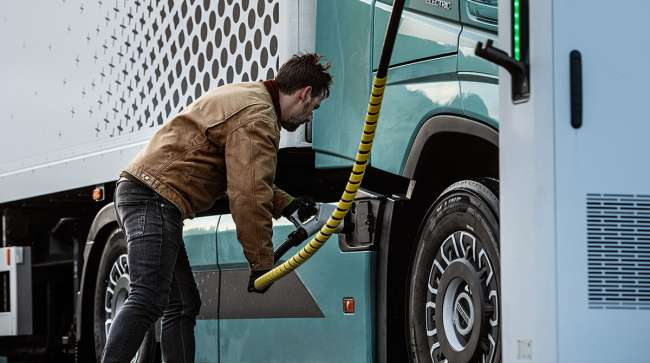Senior Reporter
SuperTruck 3 Pushes for Electrification of Freight Trucks

[Stay on top of transportation news: Get TTNews in your inbox.]
The Department of Energy intends to provide up to $100 million in funding to push for the electrification of freight trucks of all sizes as part of its new SuperTruck 3 program.
A parallel, separately funded, effort will be aimed at reducing emissions and increasing efficiencies for on- and off-road vehicles, among other goals.
Transportation accounts for approximately 30% of total U.S. energy needs and generates the largest share of the country’s greenhouse gas emissions, according to DOE.
We're throwing greenhouse gases under the bus. At @ENERGY, we’re committing $162 million to decarbonize vehicles of all different sizes to make them cleaner and greener to get from place to place. Get the details: https://t.co/ix0cVCftzL pic.twitter.com/qUcft6Lvtc — Secretary Jennifer Granholm (@SecGranholm) April 15, 2021
“To reach our goal of a net zero carbon economy by 2050 we absolutely have to figure out a way to drive those emissions down,” Energy Secretary Jennifer Granholm said during a webinar announcing the funding.
Granholm added there needed to be “a full-out war” on the climate crisis. “Any medium or heavy truck on the road, we want them to run on cleaner alternative energy.”
At the same time, America can also claim its share of a global clean energy market, she said, “which means creating millions of jobs for our workers and directing the benefits into communities that have been left behind.”
The funding for trucks — subject to anticipated congressional appropriations and intended to be spread over four years — will focus on a range of approaches to electrification: all-electric, plug-in hybrid systems using renewable biofuels, and hydrogen and fuel cell technologies, including hybridization strategies such as fuel cell range extenders, according to DOE.
DOE’s Office of Energy Efficiency and Renewable Energy’s Vehicle Technologies Office and Hydrogen and Fuel Cell Technologies Office are partnering on the SuperTruck 3 program.

Braswell
For members of American Trucking Associations’ Technology & Maintenance Council “the challenge is for industry to keep fleet maintenance concerns, procedures, nomenclature and specification standardization in the foreground of the process of introducing these green technology — electric, fuel-cell electric — vehicles,” TMC Executive Director Robert Braswell told Transport Topics.
“TMC is working on these and other issues related to this technological revolution through our various study groups and task forces and looks forward to playing a key role in this effort,” Braswell added.
DOE launched the SuperTruck initiatives in 2009 to improve heavy-duty truck freight efficiency by 50%. The follow-up SuperTruck 2 in 2016 sought to double fuel efficiency for Class 8 trucks.
The initiatives attracted participation of truck makers comprising over 99% of the U.S. truck market. Within seven years, four of them — Volvo, Daimler, Peterbilt-Cummins and Navistar — exceeded the first SuperTruck goal, DOE noted.
Meanwhile, the five SuperTruck 2 projects are on track to more than double Class 8 miles per gallon.
“SuperTruck was so successful because it required a tractor and a trailer to be built and be out on the road to do some of that [technology] validation,” said Mike Roeth, executive director of the North American Council for Freight Efficiency, who participated in the call.
NACFE Joins DOE Secretary Granholm for 'Fireside Chat' – Mike Roeth was honored to be part of the SuperTruck 3 announcement.https://t.co/TaBZ0NAGuq pic.twitter.com/9rttcx2wYA — North American Council for Freight Efficiency (@NACFE_Freight) April 22, 2021
Roeth and two truck drivers, also on the call, encouraged DOE to begin putting charging infrastructure in place to test what will work best in eventual large-scale deployments.
“There are still a lot of challenges with the charging infrastructure,” Roeth said. “With how fast [does it happen], how do we manage the charging, the grid’s resiliency. All that can be tested a little bit with these albeit one-off deployments but really important early efforts.”
Joel Morrow, a driver and the person in charge of evaluating new technology at Ploger Transportation, said the company likes to think of itself as a cutting-edge fleet and it has participated in NACFE’s Run On Less demonstrations.
“We would love to deploy a couple of electric vehicles in our local operations but there simply is no infrastructure to support that. So we are on the sidelines,” Morrow said.
Roeth said Run on Less has acted like a “validator of the SuperTruck program’s earlier efforts as well as those of truck makers and suppliers.”
The latest Run On Less set for this September involves a range of electric vehicles and operating environments.
Clark Reed, a driver with Nussbaum Transportation, said he approached the new technology finding its way into Class 8 vehicles with this mindset: “You can get in the truck and drive it. Or you can get in the truck and manage it and drive it to save fuel, keep yourself safer and the environment cleaner. All those things work hand in hand.”
Separately, DOE intends to provide up to $62.75 million to support — in addition to reducing emissions in on- and off-road vehicles — expansion of electric vehicle infrastructure and charging, along with community-level EV demonstrations that can lower barriers to EV adoption — such as piloting EV car sharing and installing EV charging within multiunit housing.
Want more news? Listen to today's daily briefing below or go here for more info:

